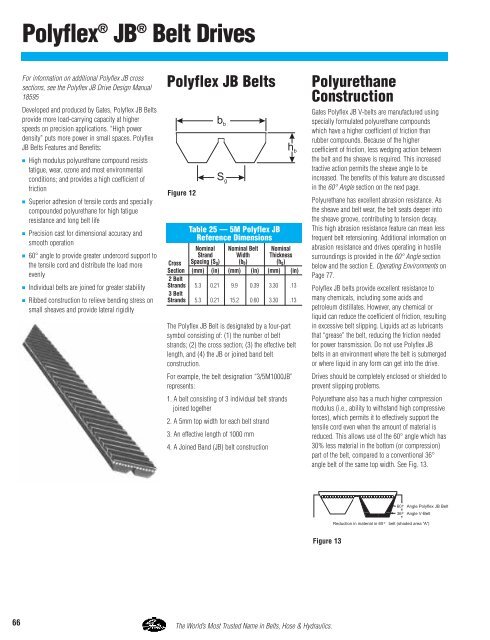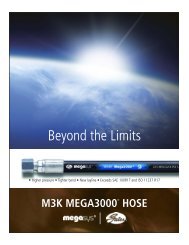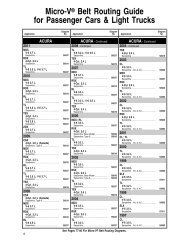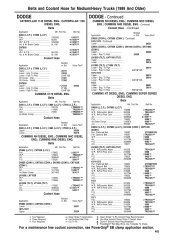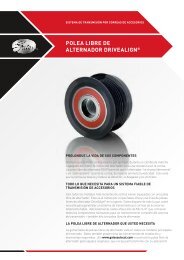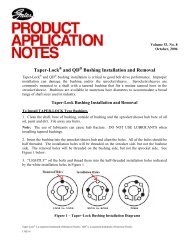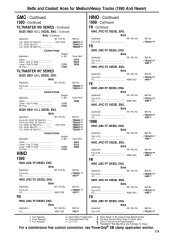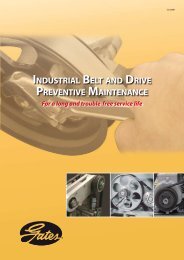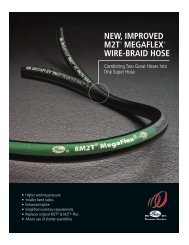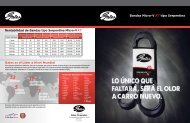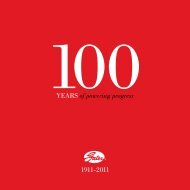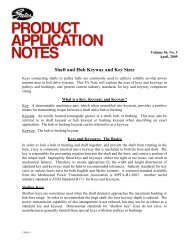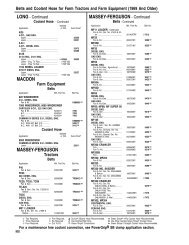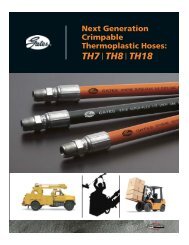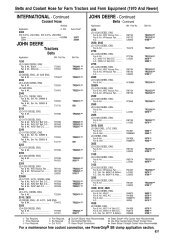PowerGrip® GT® Belt Drives
PowerGrip® GT® Belt Drives
PowerGrip® GT® Belt Drives
Create successful ePaper yourself
Turn your PDF publications into a flip-book with our unique Google optimized e-Paper software.
Polyflex ® JB ® <strong>Belt</strong> <strong>Drives</strong><br />
For information on additional Polyflex JB cross<br />
sections, see the Polyflex JB Drive Design Manual<br />
18595<br />
Developed and produced by Gates, Polyflex JB <strong>Belt</strong>s<br />
provide more load-carrying capacity at higher<br />
speeds on precision applications. “High power<br />
density” puts more power in small spaces. Polyflex<br />
JB <strong>Belt</strong>s Features and Benefits:<br />
■<br />
■<br />
■<br />
■<br />
■<br />
■<br />
High modulus polyurethane compound resists<br />
fatigue, wear, ozone and most environmental<br />
conditions; and provides a high coefficient of<br />
friction<br />
Superior adhesion of tensile cords and specially<br />
compounded polyurethane for high fatigue<br />
resistance and long belt life<br />
Precision cast for dimensional accuracy and<br />
smooth operation<br />
60° angle to provide greater undercord support to<br />
the tensile cord and distribute the load more<br />
evenly<br />
Individual belts are joined for greater stability<br />
Ribbed construction to relieve bending stress on<br />
small sheaves and provide lateral rigidity<br />
Polyflex JB <strong>Belt</strong>s<br />
Figure 12<br />
b b<br />
S g<br />
Standard Table <strong>Belt</strong> 25 Nomenclature — 5M Polyflex JB<br />
Reference Dimensions<br />
h b<br />
Nominal Nominal <strong>Belt</strong> Nominal<br />
Strand Width Thickness<br />
Cross Spacing (S g) (b b) (h g)<br />
Section (mm) (in) (mm) (in) (mm) (in)<br />
2 <strong>Belt</strong><br />
Strands 5.3 0.21 9.9 0.39 3.30 .13<br />
3 <strong>Belt</strong><br />
Strands 5.3 0.21 15.2 0.60 3.30 .13<br />
The Polyflex JB <strong>Belt</strong> is designated by a four-part<br />
symbol consisting of: (1) the number of belt<br />
strands; (2) the cross section; (3) the effective belt<br />
length, and (4) the JB or joined band belt<br />
construction.<br />
For example, the belt designation “3/5M1000JB”<br />
represents:<br />
1. A belt consisting of 3 individual belt strands<br />
joined together<br />
2. A 5mm top width for each belt strand<br />
3. An effective length of 1000 mm<br />
4. A Joined Band (JB) belt construction<br />
Polyurethane<br />
Construction<br />
Gates Polyflex JB V-belts are manufactured using<br />
specially formulated polyurethane compounds<br />
which have a higher coefficient of friction than<br />
rubber compounds. Because of the higher<br />
coefficient of friction, less wedging action between<br />
the belt and the sheave is required. This increased<br />
tractive action permits the sheave angle to be<br />
increased. The benefits of this feature are discussed<br />
in the 60° Angle section on the next page.<br />
Polyurethane has excellent abrasion resistance. As<br />
the sheave and belt wear, the belt seats deeper into<br />
the sheave groove, contributing to tension decay.<br />
This high abrasion resistance feature can mean less<br />
frequent belt retensioning. Additional information on<br />
abrasion resistance and drives operating in hostile<br />
surroundings is provided in the 60° Angle section<br />
below and the section E. Operating Environments on<br />
Page 77.<br />
Polyflex JB belts provide excellent resistance to<br />
many chemicals, including some acids and<br />
petroleum distillates. However, any chemical or<br />
liquid can reduce the coefficient of friction, resulting<br />
in excessive belt slipping. Liquids act as lubricants<br />
that “grease” the belt, reducing the friction needed<br />
for power transmission. Do not use Polyflex JB<br />
belts in an environment where the belt is submerged<br />
or where liquid in any form can get into the drive.<br />
<strong>Drives</strong> should be completely enclosed or shielded to<br />
prevent slipping problems.<br />
Polyurethane also has a much higher compression<br />
modulus (i.e., ability to withstand high compressive<br />
forces), which permits it to effectively support the<br />
tensile cord even when the amount of material is<br />
reduced. This allows use of the 60° angle which has<br />
30% less material in the bottom (or compression)<br />
part of the belt, compared to a conventional 36°<br />
angle belt of the same top width. See Fig. 13.<br />
60°<br />
Angle Polyflex JB <strong>Belt</strong><br />
36°<br />
Angle V-<strong>Belt</strong><br />
Reduction in material in 60°<br />
belt (shaded area “A”)<br />
Figure 13<br />
66 The World’s Most Trusted Name in <strong>Belt</strong>s, Hose & Hydraulics.


